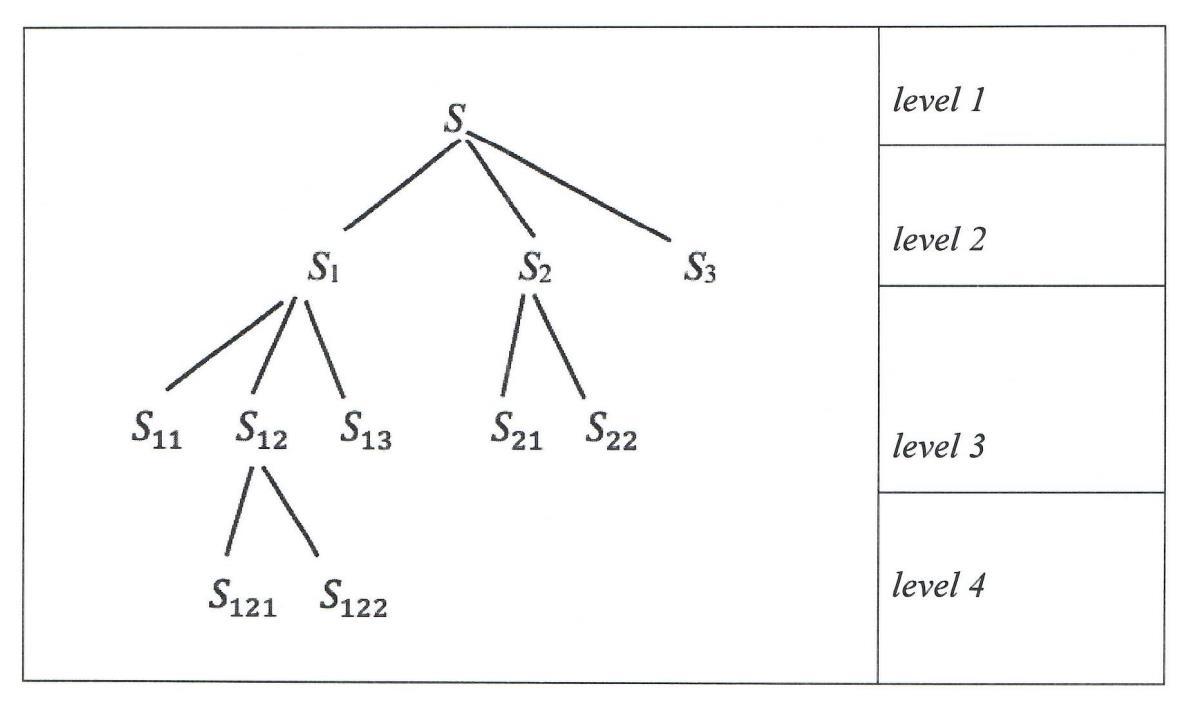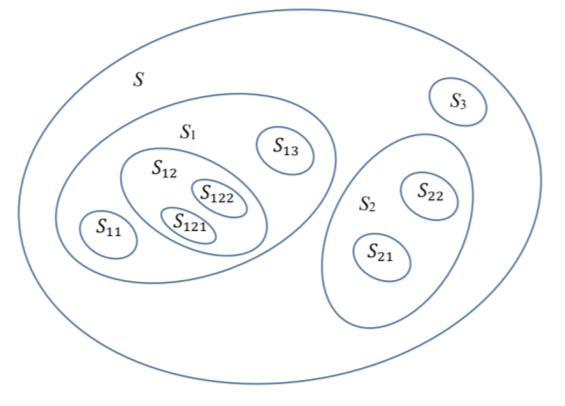
7 minute read
The SuperHyperFunction and the Neutrosophic SuperHyperFunction
Florentin Smarandache
Advertisement
Florentin Smarandache (2022). The SuperHyperFunction and the Neutrosophic SuperHyperFunction. Neutrosophic Sets and Systems 49, 594-600
Abstract: In this paper, one recalls the general definition of the SuperHyperAlgebra with its SuperHyperOperations and SuperHyperAxioms [2, 6]. Then one introduces for the first time the SuperHyperTopology and especially the SuperHyperFunction and Neutrosophic SuperHyperFunction. One gives a numerical example of a SuperHyperGroup.
Keywords: SuperHyperAlgebra; SuperHyperFunction; Neutrosophic SuperHyperFunction; SuperHyperOperations; SuperHyperAxioms; SuperHyperTopology.
1. System of Sub-Systems of Sub-Sub-Systems and so on
A system may be a set, space, organization, association, team, city, region, country, etc. One considers both: the static and dynamic systems.
With respect to various criteria, such as: political, religious, economic, military, educational, sportive, touristic, industrial, agricultural, etc., a system S is made up of several sub-systems S1, S2, …, Sp, for integer �� ≥1; then each subsystem Si, for �� ∈{1,2,…,��} is composed of many sub-sub-systems ����1, ����2, …, ��������, for integer ���� ≥ 1; then each sub-sub-system ������, for ��∈ {1,2,…,����} is composed sub-sub-sub-systems, ������1, ������2, …,
����������, for integer ���� ≥1; and so on.
2. Example 1 of Systems made up of Sub-Sub-Sub-Systems (Level 4)
i) Using a Tree-Graph Representation, one has:
ii) Using a Geometric Representation, one has:

iii) Using an Algebraic Representation through pairs of braces { }, one has:
��0(��)≝�� ={��,��,��,��,��,��,��,ℎ,��}
1 level of pairs of braces
��1(��)≝��(��)∋{{��,��,��,��,��},{��,��,ℎ},{��}}
2 levels of pairs of braces i.e. a pair of braces { } inside, another pair of braces { }, or { … { … } … }
��2(��)≝��(��(��)) ∋{{{��},{��,��,��},{��}},{{��},{��,ℎ}},{��}}}
3 levels of pairs of braces
��3(��)≝��(��2(��)) ∋{{{��},{��,��},{��},{��}},{{��},{��,ℎ}},{��}}
4 levels of pairs of braces 1level of closed curves
2 levels of closed curves
3 levels of closed curves
4 levels of closed curves level 1
level 2
level 3
level 4
where the symbol “∋” means “contain(s)”, it is the opposite of the symbol “∈” (belong(s) to), for example �� ∋�� means the set M contains the element x, which is equivalent to �� ∈��.
2.1 Remark 1
The pairs of braces { } make a difference on the struture of a set. For example, let’s see the distinction between the sets A and B, defined as bellow:
A = {��,��,��,��} represents a system (organization) made up of four elements, while B = {{��,��},{��,��}} represents a system (organization) made up of two sub-systems and each sub-system made up of two elements. Therefore B has a richer structure, it is a refinement of A.
3. Definition on nth-Power of a Set
The nth-Power of a Set (2016) was introduced by Smarandache in the following way: ����(��), as the nth -PowerSet of the Set S, for integer �� ≥1, is recursively defined as:
��2(��)=��(��(��)), ��3(��)=��(��2(��))=��(��(��(��))), …, ����(��)=��(����−1(��)), where ��0(��)≝��, and ��1(��)≝��(��).
The nth-Power of a Set better reflects our complex reality, since a set S (that may represent a group, a society, a country, a continent, etc.) of elements (such as: people, objects, and in general aany items) is organized onto subsets ��(��), which on their turns are also organized onto subsets of subsets, and so on. That is our world.
In the classical HyperOperation and Classical HyperStructures, the empty set ∅ does not belong to the power set, or ��∗(��) = P(S) ∖ {∅}.
However, in the real world we encounter many situations when a HyperOperation ∘ is: • indeterminate, for example a∘b=∅ (unknown, or undefined), • or partially indeterminate, for example a∘b={[0.2,0.3],∅}.
In our everyday life, there are many more operations and laws that have some degrees of indeterminacy (vagueness, unclearness, unknowingness, contradiction, etc.), than those that are totally determinate.
That is why is 2016 we have extended the classical HyperOperation to the Neutrosophic HyperOperation, by taking the whole power P(S) (that includes the empty-set ∅ as well), instead ��∗(��) (that does not include the empty-set ∅), as follows.
3.1 Remark 2
Throughout this paper the definitions, theorems, remarks, examples and applications work for both classical-type and Neutrosophic-type SuperHyper-Algebra and SuperHyper Function.
3.2 Theorem 1
Let S be a discrete finite set of 2 or more elements, and �� ≥1 an integer. Then: ��0(��)⊂��1(��)⊂��2(��)⊂⋯⊂����−1(��)⊂����(��).
Proof
For a discrete finite set ��={��1,��2,…,����} for integer �� ≥2 one has: ��0(��)≡�� ={��1,��2,…,����}. ��1(��)=��(��) ={��1,��2,…,����;{��1,��2},{��1,��2,��3},…,{��1,��2,…,����}}, and cardinal of P(S) is ��������(��(��))=���� 1 +���� 2 +⋯+���� �� =2�� −1, where ���� �� , 1≤�� ≤��, means combinations of m elements taken in groups of i elements.
It is clear that ��0(��)⊂��1(��).
In general, one computes the set of ����+1(��) by taking the set of the previous ����(��)= {��1,��2,…,����}, where �� =��������(����(��)), and making all possible combination of its r elements; but, at the beginning, when one takes the elements only by one, we get just ����(��), afterwards one takes the elements in group of two, then in groups of three, and so on, and finally all r elements together as a single group.
4. Definition of SuperHyperOperations
We recall our 2016 concepts of SuperHyperOperation, SuperHyperAxiom, SuperHyperAlgebra, and their corresponding Neutrosophic SuperHyperOperation Neutrosophic SuperHyperAxiom and Neutrosophic SuperHyperAlgebra [2].
Let ��∗ ��(��) be the nth-powerset of the set H such that none of P(H), P2(H), …, Pn(H) contain the empty set.
Also, let ����(��) be the nth-powerset of the set H such that at least one of the P2(H), …, Pn(H) contain the empty set.
The SuperHyperOperations are operations whose codomain is either ��∗ ��(��) and in this case one has classical-type SuperHyperOperations, or ����(��) and in this case one has Neutrosophic SuperHyperOperations, for integer n 2 .
4.1 Classical-type m-ary SuperHyperOperation {or more accurate denomination (m, n)-SuperHyperOperation}
Let �� be a universe of discourse and a non-empty set ��, �� ⊂��. Then:
* ( , ) *m n : ( ) m n
H P H →
where the integers ��,�� ≥1,
and ��∗ ��(��) is the nth-powerset of the set �� that includes the empty-set.
This SuperHyperOperation is a m-ary operation defined from the set H to the nth-powerset of the set ��.
4.2 Neutrosophic m-ary SuperHyperOperation {or more accurate denomination Neutrosophic (m, n)-SuperHyperOperation}
Let �� be a universe of discourse and a non-empty set ��, �� ⊂��. Then:
( , ) m n : ( ) m n H P H →
where the integers ��,�� ≥1; ( )n P H - the n-th powerset of the set H that includes the empty-set.
5. SuperHyperAxiom
A classical-type SuperHyperAxiom or more accurately a (m, n)-SuperHyperAxiom is an axiom based on classical-type SuperHyperOperations.
Similarly, a Neutrosophic SuperHyperAxiom {or Neutrosphic (m, n)-SuperHyperAxiom} is an axiom based on Neutrosophic SuperHyperOperations.
There are: • Strong SuperHyperAxioms, when the left-hand side is equal to the right-hand side as in non-hyper axioms, • and Week SuperHyperAxioms, when the intersection between the left-hand side and the right-hand side is non-empty.
For examples, one has: • Strong SuperHyperAssociativity, when (��∘��)∘�� =��∘(��∘��) , for all ��,��,�� ∈���� , where the law * ( , ) *
m n : ( ) m n H P H → ;
• and Week SuperHyperAssociativity, when [(��∘��)∘��]∩[��∘(��∘��)]≠ , for all ��,��,�� ∈���� .
6. SuperHyperAlgebra and SuperHyperStructure
A SuperHyperAlgebra or more accurately (m-n)-SuperHyperAlgebra is an algebra dealing with SuperHyperOperations and SuperHyperAxioms.
Again, a Neutrosophic SuperHyperAlgebra {or Neutrosphic (m, n)-SuperHyperAlgebra} is an algebra dealing with Neutrosophic SuperHyperOperations and Neutrosophic SuperHyperOperations.
In general, we have SuperHyperStructures {or (m-n)-SuperHyperStructures}, and corresponding Neutrosophic SuperHyperStructures.
For example, there are SuperHyperGrupoid, SuperHyperSemigroup, SuperHyperGroup, SuperHyperRing, SuperHyperVectorSpace, etc.
since [−1,0]∩[0,5]=[0,0]
since [6,7]∩[0,5]= ∅. ������(5)={[4,5],∅}
Conclusion
In this paper we recalled the concepts of SuperHyperAlgebra and Neutrosophic HyperSuperAlgebra, and presented an example of SuperHyperGroup. Then, for the first time one introduces and gives examples of SuperHyperFunction and Neutrosophic SuperHyperFunction.
References
1. A. Rezaei, F. Smarandache, S. Mirvakili (2021). Applications of (Neutro/Anti)sophications to
SemiHyperGroups. Journal of Mathematics, 1–7. https://www.hindawi.com/journals/jmath/2021/6649349/ 2. F. Smarandache (2016). SuperHyperAlgebra and Neutrosophic SuperHyperAlgebra, Section into the authors book Nidus Idearum. Scilogs, II: de rerum consectatione, second edition, Bruxelles: Pons, 107. https://digitalrepository.unm.edu/math_fsp/209/ 3. F. Smarandache (2019). n-SuperHyperGraph and Plithogenic n-SuperHperGraph, in Nidus Idearum. Scilogs, VII: superluminal physics, second and third editions, Bruxelles: Pons, 107-113. https://digitalrepository.unm.edu/math_fsp/301/ 4. F. Smarandache (2020). Extension of HyperGraph to n-SuperHyperGraph and to Plithogenic nSuperHyperGraph, and Extension of HyperAlgebra to n-ary (Classical-/Neutro-/Anti-)HyperAlgebra. Neutrosophic Sets and Systems, 33, 290–296. https://digitalrepository.unm.edu/math_fsp/348/ 5. F. Smarandache (2022). Introduction to the n-SuperHyperGraph - the most general form of graph today. Neutrosophic Sets and Systems, 48, 483–485. http://fs.unm.edu/NSS2/index.php/111/article/view/2117 6. F. Smarandache (2022). Introduction to SuperHyperAlgebra and Neutrosophic SuperHyperAlgebra. Journal of Algebraic Hyperstructures and Logical Algebras, Inpress, 8. https://www.researchgate.net/publication/359511702_Introduction_to_SuperHyperAlgebra_and_Neutros ophic_SuperHyperAlgebra 7. M.A. Ibrahim, A.A.A. Agboola (2020). Introduction to NeutroHyperGroups, Neutrosophic Sets and
Systems, 38, 15-32. https://digitalrepository.unm.edu/nss_journal/vol38/iss1/2/ 8. D. Molodtsov (1999). Soft Set Theory – First Results. Computer Math. Appl., 37, 19-31. 9. F. Smarandache (2018). Extension of Soft Set to Hypersoft Set, and then to the Plithogenic Hypersoft Set. Neutrosophic Sets and Systems, 22, 168–170. https://digitalrepository.unm.edu/cgi/viewcontent.cgi?article=1309&context=math_fsp






